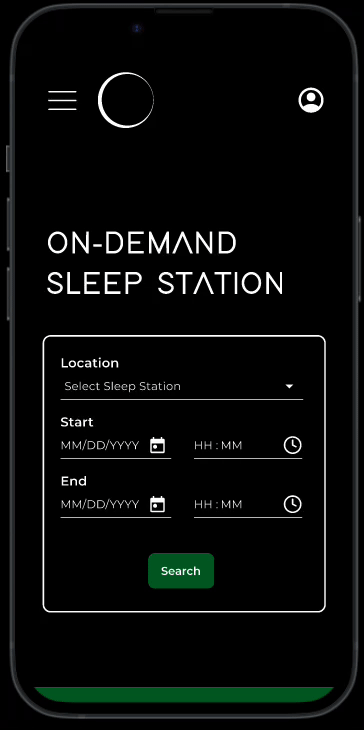Sleep Station Booking Platform
Reservation Web-Application
Roles
UX/UI Designer
Tools
Figma
Skills Used
User Experience Design, Ideation & Prototyping, Customer Journey Map, Interface Design
Scope
Digital Product, UX/UI
Overview
I led the design and product development from the ground up, collaborated closely with the development team, and built the Hospitality application. The application was designed to support business growth and expansion, elevating the experience and ensuring brand consistency, business scalability, and opportunities for upselling services. The project was divided into 3 phases of development, with Phase 1 focusing on the Reservation Platform.
In this phase, the platform integrated hourly and overnight stays into a seamless experience, eliminated the need for multiple accounts and websites, and made booking faster and more intuitive for guests.
Research Key Insights
Industry & User Observations Driving the Problem Statement and Design Decision
01
Industry Gaps in Reservation Platforms
Business Needs
Existing hospitality systems do not fully support both hourly and overnight bookings in a single platform, leading to operational inefficiencies.
02
Fragmented Booking Experience
User Needs
Guests must navigate multiple platforms and create separate accounts, causing confusion, extra steps, and higher drop-off rates.
03
Need for Simplicity & Efficiency
Business & User Needs
As an on-demand sleep station, a seamless, streamlined booking process is essential to reduce complications and improve user experience, as research shows that simpler flows lead to higher conversion rates.
04
Mobile Optimization is Crucial
User Needs
With the growth of mobile bookings, a mobile-first design ensures usability and convenience for guests booking on the go.
Problems
Multiple Booking Systems
Lengthy Reservations
Brand Experience Inconsistent
Objectives
Unify the Booking System
Make Reservations Faster & Easier
Ensure Brand Experience & Visual Consistency
Support Business Growth & Opportunities
Process
User Experience (UX) Approach
User Flow & Journey Mapping
The phrase one of user flow and journey mapping mainly focused on search sorting and creating a seamless booking process. The challenge lay in the account creation step, which could have led to drop-offs and burdened users in continuing the booking process. Integrating and leveraging commonly used systems, such as Google accounts, aided the transition and minimized the journey steps.
Site Map
This overview site map gave a rough idea of the overall structure of the entire application platform and the need for the application to support the user journey.
Wireframe
The wireframe allowed the team to visualize the flow and gain a sense of the user experience, ensuring that all required elements of features and functions were incorporated and considered in the design, including any micro-actions.
Feedback
The wireframe displayed fill-in fields for account creation and billing information. Additionally, some booking requirement policies made the page feel like a long scroll, which could have burdened and overwhelmed the user.
The iteration and adjustments were implemented in the UI design process.
Design
User Interface Design (UI)
Search Booking for Hourly and Overnight Integration
Search Booking Flow
The design simplifies date and time entry into a single modal screen, reducing extra steps. Automated service sorting determines whether the booking is hourly or overnight, ensuring accurate search results and pricing for a seamless booking experience.
Easy Steps to Complete Booking
A progress bar provides users with clear visibility of their journey, ensuring a structured and guided experience does not feel overwhelming.
Step 01 - Account Creation/Login
Aligning to support the business’ future expansion and personalized experiences, guests must create an account. Integration with Google login minimizes friction by enabling quick sign-in and auto-filling information. A manual sign-up option with email and password is available with minimal info entry, ensuring accessibility for all users.
Step 02 - Reservation Policy Submission
For legal and security compliance, guests must upload an ID document and agree to the Terms & Conditions. The process is split into two steps to prevent overwhelming users and ensure clarity.
Step 03 - Payment
A minimal and efficient payment form requests only essential details. Returning guests can use pre-saved payment methods, while integration with Apple Pay provides a one-click checkout experience for faster processing.












